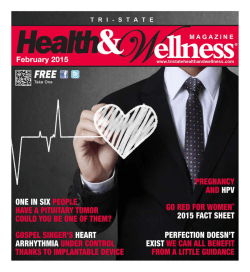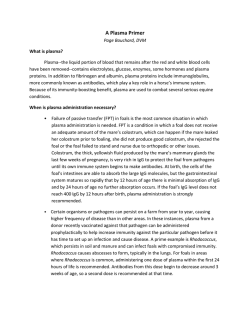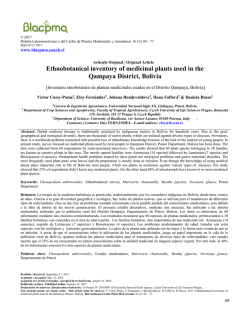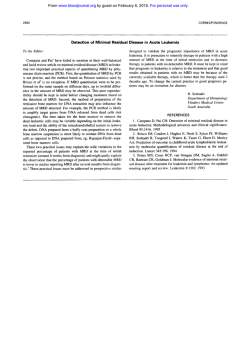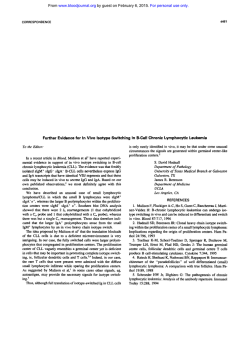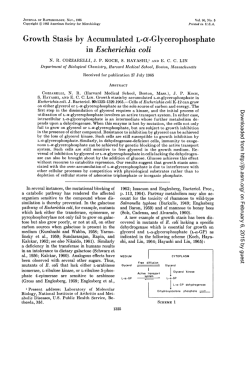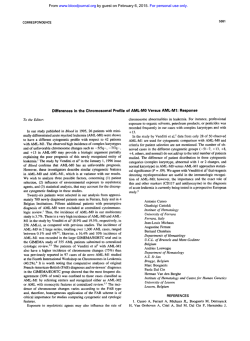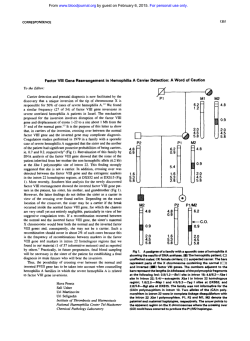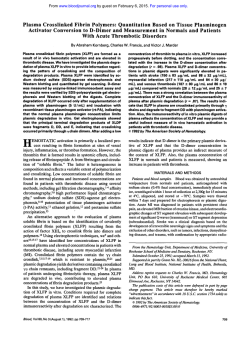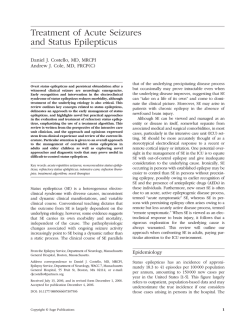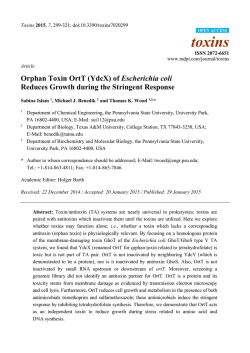
Role of Free Protein S and C4b Binding Protein in
From www.bloodjournal.org by guest on February 6, 2015. For personal use only. Role of Free Protein S and C4b Binding Protein in Regulating the Coagulant Response to Escherichia coli By F.B. Taylor, Jr, B. Dahlback, A.C.K. Chang, MS. Lockhart, K. Hatanaka, G . Peer, and C.T. Esmon Previous studies showed that infusion of C4b-binding protein with sublethal Escherichia coli (€. coli) in the primate produced a consumptive coagulopathy followed by microvascular thrombosis and renal failure.The first objective of this study was to characterize the pathophysiology and mechanism of this phenomena following infusion of both these agentswith emphasis ondefining the role of free protein S. The second objective was to examine the relevance of this model t o the hemolytic uremic syndrome. Infusion of C4b-bindingprotein alone reduced freeprotein S and decreased platelet concentration to 20% of baseline, whereas infusion of the C4b-binding proteinlprotein S complex did not. There was no activation of other inflammatory or coagulant factors. Infusion of sublethal E coli alone produced a transient inflammatory response with no reduction of free protein S. However, coinfusion of C4b-binding protein with sublethal E coli reducedfree protein S andproduced a thrombocytopenia, anemia, and a microvascularthrombotic response, whereas infusion of the C4b-binding protein/protein S complex with sublethal Ecolidid not. Studies comparing the effects of neutralizing (S-163) and nonneutralizing (S-145) antibodies with protein S coinfused with sublethal E coli produced similar contrasting results. Therefore, we concludedthat neutralization of freeprotein S, and not some other property of C4b-binding protein influenced by protein S, accounted for this microvascular thrombotic response. This response is similar t o the hemolytic uremic syndrome characterized by thrombocytopenia, anemia, shistocytosis, and renal glomerularthrombosis with uremia. Comparison of the respective renalhistopathologic appearance supports this conclusion. This raisesthe possibility that inhibition of protein S activity (possibly by one ofthe forms of C4b-binding proteins) might be one of the factors contributing to microvascular thrombotic disorder, such as the hemolytic uremic syndrome. Q 1995 by The American Society of Hematology. D coli alone normally produces only a transient sympathomimetic,inflammatoryresponse with no evidence ofa sustained release of cytokines,consumptive coagulopathy or microvascular thrombosis. However, we found that coinfusion of C4bBP with sublethal E coli produced a lethal inflammatory, coagulopathic response.” The purpose of this report is: (1) to study the mechanism of this phenomena and determine whether infusion of C4bBP reduces free protein S in vivo, and whether or not the response to infusion of C4bBP plus sublethal E coli is related to reduction of free protein S concentration; and (2) characterize more completely the pathophysiology of this response with the goal of determining how closely this response mimics thehemolyticuremic syndromet4and thethrombotic thrombocytopenic purpuraI5 seen in clinical practice. EFICIENCIES OF protein C’ and protein S2 have been associated with deep vein thrombosis. These include both and acquired deficiencie~.~” Acquired deficiencies of protein S have been associated with inflammatory disorders suchaslupuserythematosus in which thereare elevations of acutephase proteins, one ofwhichis C4b binding protein.’ This protein binds to and neutralizes the activated protein C cofactor activity of protein S.”” Protein S circulates in plasma in both the free and bound forms. 70% is Normally, about 30% to 40% is free and 60% to bound to C4bBP protein.’* It has beenpostulated that elevation of C4bBP to two to three timesnormal concentrations, such as might occur in inflammation, could produce an acquired deficiency of protein S by binding and neutralizing the remaining free protein Infusion of C4b bindingprotein alone (20 mgkg) produces no changes from normal, except fora decline in platelet count at T +24 hours.” Infusion of sublethal Escherichia From the Oklahoma Medical Research Foundation, Program of Cardiovascular Biology and Howard Hughes Medical Institute, Oklahoma City: University of Oklahoma Health Sciences Center, Program of Cardiovascular Biology, Oklahoma City; University of Lund, the Department of Clinical Chemistry, Malmo, Sweden; and Developmental Research Laboratories, Shionogi & CO LTD. Osaka, Japan. Submitted August 19, 1994; accepted June 7, 1995. Supported in part by National Institutes of Health Grant No. R37 HL30340 to C.T.E. and Grant No. 2ROI GM37704 to F.B.T.. C.T.E. is an investigator at the Howard Hughes Medical Institute. Address reprint requests to F.B. Taylor, Jr, MD, Curdiovascular Biology Research, Oklahoma Medical Research Foundation, 825 NE 13th St, Oklahoma City, OK 73104. The publicationcosts of this article were defrayed in part by page charge payment. This article must therefore be hereby marked “advertisement” in accordance with 18 U.S.C. section 1734 solely to indicate this fact. 0 1995 by The American Society of Hematologv. 0006-4971/95/8607-0034$3.00/0 2642 MATERIALS AND METHODS Materials C4b binding protein (C4bBP), protein S preparation: C4bBP and protein S used in the infusion studies were prepared from human plasma as described p r e v i o ~ s l y .Protein ’~ S is a cofactor for activated protein C, which when added to the Xa one-stage assay, increases theclottingtime by cleavageandinactivation of factors Va and VIITa. The inhibition of protein S cofactor activity by C4bBP was determined using the Xa one-stage assay to which activated protein C was added as described previously.” Approximately 400 pg of C4bBP per milliliter of plasma was sufficient to reduce the clotting time from 100 seconds to the control clotting time (ie. no protein S in assay) of 35 seconds. S used in the Thegoatpolyclonalantibodytohumanprotein enzyme-linkedimmunosorbent assay (ELISA)andimmunoblot assays and a similar antibody to human C4bBP used in the ELISA assays were affinity purified by adsorption to protein S, and C4bBP coupled to affigel, respectively, and were then eluted with 0. I mol/ L glycine, ethylenediaminetetraacetic acid, pH 2.5. Monoclonal antibody preparation. Balb/cmice(JacksonLabs, Bar Harbor, ME) were immunized intraperitoneal (IP) three times with 100 pg of human C4bBP or protein S per injection at 2-week intervals. After a 2-month rest, they were then injected with 50 p g Blood, Vol 86, No 7 (October l ) , 1995: pp 2642-2652 From www.bloodjournal.org by guest on February 6, 2015. For personal use only. 2643 ROLE OF FREE PROTEIN S AND C4bEP of antigen and fusion performed 3 days later. A myeloma cell line (P3-X-63-Ag8-653, 1.5 x lo7 viable cells) was mixed with 1.7 X 10' viable spleen cells from one animal and fused by standard procedures using polyethylene glycol (PEG) 1500. After selection in hypoxanthine, aminopterin, thymidine (HAT) medium, culture supernates were tested for binding activity to the appropriate antigen(?.). Positive clones were resubcloned twice by limit dilution. For production of ascites fluid, approximately 5 X IO6 hybridoma cells were injected per Balb/c mouse 2 weeks after Pristane treatment. S-159, BP 91 isolation. Ascites fluid was diluted 1:1 with H20 and then precipitated by the addition of equal volumes of saturated NH4S04. The precipitate was harvested by centrifugation and desalted into 0.27 mol/L Tris-PO.,, pH 6.3, before chromatography on a QAE Sephadex Q50 column (Sigma Chemical CO, St Louis, MO) (1 mL resin/mL ascites), equilibrated in the above buffer. The column was developed with a linear gradient from 0 to 0.4 mom NaCl (total volume five X the column volume) over approximately 8 hours. The antibody was precipitated with 50% NH4S04,the pellet harvested by centrifugation, resuspended in a minimum volume of 0.1 m o w NaCI, I mmol/L 3-[N-Morpholino] propane sulfonic acid (MOPS), pH 7.5, before further purification on a Sephadex G-200 column, equilibrated in this buffer. S-163, S-145. S-l63 is a neutralizing monoclonal antibody directed against the first epidermal growth factor (EGF) domain of protein S. S-l45 is a nonneutralizing antibody directed against an epitope that is not required for protein S cofactor activity. These antibodies were prepared and isolated as described above for S-l59 and BP-9 1. E coli organisms (ATCC 33 985 Type B7-086a:Kl) used in the infusion study were isolated from a stool specimen at Children's Memorial Hospital (Oklahoma City, OK). They were stored in the lyophilized state at4°C after growth in tryptic soybean agar and reconstituted and characterized as described previo~sly.'~ Preexperimentation and Experimentation Procedures Papio c cynocephalus or Papio c anubis baboons were purchased from a breeding colony maintained at the University of Oklahoma Health Sciences Center (OUHSC) or from Charles Rivers, Inc (Houston, TX). Animals weighed 4 to 9 kg, had leukocyte concentrations of 5,000 to 10,0W/mm3,and hematocrits exceeding 36%. They were free of tuberculosis. These animals were held for 30 days at the UOHSC animal facility where the infusion studies were done. The animals were observed continuously during the first 6 hours postinfusion and at 24 hours all animals were killed and tissues examined. Sampling Mean systemic arterial pressure (MSAP) and heart rate were monitored with a Stathem pressure transducer and Hewlett Packard (Avondale, PA) recorder. Rectal temperature was measured with a Telethermometer (Yellow Springs Instrument CO, Yellow Springs, OH). The above measurements were made, and blood samples were collected at T -l/*, 0, + l , +2, +3, +4, +5, +6, and at 24 hours. T -0 designated the point at which the infusion of E coli was started. Not more than 10% of calculated blood volume (70 -g) was withdrawn over the 6-hour monitoring period. The blood collected at the times indicated above included: 1 mL anticoagulated with EDTA acid for complete blood count, including hematocrit, platelet and differential counts; 2 mL anticoagulated with 3.8% sodium citrate for fibrinogenf6and for ELISA, immunoblot and gel filtration analysis of C4b binding protein S, 1.0 mL in trasylollthrombin for fibrin degeneration products," 3.0mLof clotted blood for blood urea nitrogen," and creatinine." Two samples of 1.0 mL each were taken at T -0 and T +2 hours for colony counts.*"All animals were killed at T +24 hours after collection of the last blood sample. Postmortem studies were performed and tissues were removed from the lungs, kidney, liver, adrenal glands, heart, and spleen for routine light microscopic examination. The study protocol received prior approval by the Institutional Animal Care and Use Committees of both the Oklahoma Medical Research Foundation and the OUHSC. Experimental Groups Table 1 shows the five groups of animals studied. Group 1 was infused with C4bBP alone (20 mgkg), group 2 C4bBP/protein S complex (20/3 mgkg), group 3 sublethal E coli alone, group 4 sublethal E coli plus C4bBP, and group 5 E coli plus C4bBP/protein S complex. T -0 was the time at which the 2-hour sublethal E coli or saline control infusions werebegun. The C4bBP and C4bBP/ protein S complex were infused as a bolus at T -30 minutes. Both C4bBP and the complex had half-lives of approximately 10 hours." An additional two groups of animals were studied in which: (1) a neutralizing monoclonal antibody to protein S (2 to 4 mgkg of S163) was substituted for C4bBP and coinfused with sublethal E coli (n = 4), and (2) a nonneutralizing monoclonal antibody to protein S (3 mgkg of S-145) was substituted for C4bBP and coinfused with sublethal E coli (n = 2). These studies were performed to test the conclusion that alteration of protein S function was responsible for the response to coinfusion of C4bBP with sublethal E coli. The infusion and sample collection procedures were identical to those described for the C4bBP studies. Infusion Procedures Experiments were performed on 24 juvenile baboons. They were fasted overnight before each experiment and administered water ad libitum. Each animal was sedated with ketamine hydrochloride (14 mgkg, intramuscularly) on the morning of the study, and anesthetized with sodium pentobarbital (2 m a g ) via a percutaneous catheter positioned in the cephalic vein. Animals were intubated orally and allowed to breathe spontaneously. The femoral artery and vein were cannulated aseptically and used for measuring arterial pressure and obtaining blood samples, respectively. The percutaneous catheter in the cephalic veinwasused for infusions of anesthetic as described previously13and a percutaneous catheter in the saphenous vein was used for infusion of E coli organisms. Each baboon was placed on its side in contact with controlled temperature heating pads. A light level of surgical anesthesia was maintained for the 6hour observation period (2 mgkg sodium pentobarbital approximately every 20 minutes). Assays The crossed immunoelectrophoretic assay used to study the concentrations of protein S and C4bBP and the partitioning of free versus bound protein S in humans was not applicable to the study of baboon protein S. Therefore, it was necessary to (1) estimate total protein S and C4bBP by ELISA, (2) develop a radioimmunoblot assay to assess the concentrations of free and bound protein S, and (3) to validate this assay by gel filtration estimates of free and bound protein S run in parallel. Protein S EWSA. Microtiter plates (Costar vinyl assay plates) were coated overnight at 4°C. with a monoclonal antibody against human protein S, (S159 or BP91). ( l pg/mL in 50 mmol/L carbonate buffer, pH 9.6, 50 &/well). The wells were washed three times with 20 m m o K Tris-HC1, 0.15 molL NaCI, 0.1% Tween-20, pH 7.5 (wash buffer) and then incubated at room temperature for 1 hour with 100 p L of 10 mg/mL bovine serum albumin (BSA) in 20 mmoll From www.bloodjournal.org by guest on February 6, 2015. For personal use only. 2644 TAYLOR ET AL Table 1. Experimental Groups Experiment No. Sex Weight (kg) E coli (CFUAg) E coli at T + 2 h (CFU/mL blood) C4bBPIPS (mgikg) - - - - 20 20 20 20 - - - - 20/3.0 20/3.0 20 lo6 106 105 - lo6 - 105 lo5 ? 1.36 - 105 105 105 105 20 20 20 20 20 C4bBP 8 10 13 Average t SE C4bBP/Protein S 16 17 Average t SE Sublethal E coli S-3 S-4 S-7 S-6 S-8 F M F M F - M M 4.2 M F 4.6 5.2 8.2 6.0 t 1 . 1 5.8 5.7 5.8 5 0.1 6.1 7.1 6.4 14.6 3.7 X 109 3.7 X 109 X 109 3.3 X 109 4.5 X lo9 M 5.7 - 8.0 3.2i- 1.7 X 1 M 2 3 7 M 3.9 2.7 2.3 5.2 3.5 t 0.6 4.9 X 38.0 X 3.0 x 2.1 X 12.0 X 7.7 1.4 3.2 7.3 4.9 t 1.5 19.3 X 23.7 x 4.3 X 6.1 X 13.3 X Average t SE C4bBP plus sublethal E coli Average i SE C4bBP/protein S plus sublethal E coli F M - 4 5 14 15 M F Average t SE - M F L Tris-HCI, 0.15 m o w NaCI, pH 7.5. After the wells were washed three times with wash buffer, diluted citrated plasma samples, which had been incubated for 2 hours at 37"C, were added in duplicate to the wells (50 pL/well). Each plasma sample was tested at two dilutions on the same plate. The diluting buffer was 20 mmol/L TrisHCI, 0.15 m o m NaCI, 1 mmol/L EDTA, pH 7.5, containing 1 mg BSNmL. The plate was incubated overnight at 4°C. After washing each well three times with wash buffer, a polyclonal antiprotein S (affinity purified v human protein S) was added to each well, (2 pg/ mL in diluting buffer, 50 pL/well). The plate was incubated for 1 hour at room temperature. After washing each well three times with wash buffer, rabbit-antigoat IgG antibody conjugated with peroxidase was added to each well, ( I : 1,000 dilution in diluting buffer, 50 pL/well). The rabbit-antigoat conjugate was incubated with an equal volume of mouse serum for 5 minutes at room temperature before dilution. The plate was incubated for 1 hour at room temperature then washed three times with wash buffer. Fifty microliters of substrate (1: 1 dilution of 2,2-azino-di-(3-ethyl-benzthiazolinesulfonate) in hydrogen peroxide (Kirkegaard and Perry Laboratories, Inc, Gaithersburg, MD) was added to each well and the plate was incubated for 20 minutes at room temperature. The absorbance at 405 nm of the wells was measured using a Vmax microplate reader (Molecular Devices, Inc, Palo Alto, CA), set to endpoint and analyzed with a 4-parameter curve fit of the normal baboon plasma dilutions. A standard curve of normal baboon plasma (seven dilutions) was used to determine the percent of total protein S of the experimental samples. The concentration of protein S in experimental samples were expressed as percent of the protein S plasma concentration at T -0. C4bBP ELSA. Microtiter plates (Costar vinyl assay plates) were 1 0 9 2 0.2 109 109 lo9 109 lo9 t 8.6 109 109 109 109 IO9 i 4.8 3.2 x 1.0 x 2.8 X 7.60 x 6.1 X 2.54 X 4.8 X 8.7 X 0.3 X 1.1 X 3.73 X 1.43 X 6.45 X 17.0 X 20/3.0 0.87 X 6.44 X 105 t 1.93 105 105 105 lo5 lo5 i 20/3.0 3.74 - - 20/3.0 20/3.0 20/3.0 coated overnight, at 4"C, with a monoclonal antibody to C4bBP, (BWl), (2.5 pg/mL in 50 mmoVL carbonate buffer, pH 9.6, 50 pL/ well). The wells were washed three times with 20 mmol/L phosphate, 0.15 moliL NaC1, 0.05% Tween-20, 0.02% NaN3, pH 7.4 (wash buffer) then incubated at room temperature for 1 hour with SO pL of 1.0 mg/mL BSA in 20 mmol/L phosphate, 0.15 mol&. NaCI, 0.02% NaN3, pH 7.4. After three washes of each well with wash buffer, 50 pL of diluted citrated plasma samples were added to the wells in duplicate, two dilutions of each. The diluting buffer was 20 mmol/L Tris-HCI, 0.15 mom NaCI, 1 mmol/L EDTA, 1 mmoll L benzamidine, 0.01% Tween-20, pH 7.4, containing 5 mg/mL BSA. The plate was incubated overnight at 4°C. After three washes with wash buffer, 50 pL of a polyclonal anti-C4bBP was added to each well (10 pg/mL diluting buffer). The plate was incubated for 1 hour at room temperature then washed three times with wash buffer. Next, 50 pL of rabbit-antigoat IgG conjugated with alkaline phosphatase was added to each well (1:250 with diluting buffer). The plate was incubated again for 1 hour at room temperature and washed three times with wash buffer. Then SO pL of p-nitrophenylphosphate (Sigma Chemical CO, St Louis, MO) (1 mg/mL 0.18 mol/L carbonate, 2 mmol/L MgClz, 0.02% NaN3, pH 8.6) was added to each well in a darkened room. The plate was incubated, in the dark, for 20 minutes and the absorbance at 405 nm was measured. The standards were analyzed using a 4-parameter curve fit of the standards. A standard curve of purified baboon C4bBP was used to determine the C4bBP concentration (micrograms per milliliter) of the samples. The experimental samples were calculated as concentration of C4bBP, = 14.1.*' pg/mL, using @To Thrombin-anrirhrombin ELISA. Thrombin-antithrombin (TAT) complexes were detected by using a sandwich ELISA, which em- From www.bloodjournal.org by guest on February 6, 2015. For personal use only. ROLE OF FREE2645 PROTEIN S AND C4bBP Table 2. Comparison of Results of Clinical Laboratory Assays of Animals Infused With C4b Binding Protein Alone and W Binding ProteirVProtein S Complex Measurement ExDerimental GrOUD MSAP (mm Hg) C4bBP C4bBPlPS Hct (mm) C4bEP Fibrinogen (% baseline) FDP (pg/dL) Platelets (x1o3/mm3) WBC (x103/mm3) BUN CR C4bBPlPS C4bBP C4bBP/PS C4bEP C4bBP/PS C4bBP C4bBPIPS C4bBP C4bBP/PS C4bBP C4bEP/PS T-0 111 t 6 104 t 21 41 t 2 40 t 2 93 t 4 100 <IO <IO 250 t 40 344 t 13 6.2 2 2.3 7 t 2.0 22 t 5 0.3 e 0.05 16 t 2 0.5 t 0.1 T+Zhrs T+6h 122 2 11 118 t 18 43 t 1 41 t 1 89 2 10 92 t 1.5 181 t 54 273 t 72 8.7 t 3.0 13.3 t 0.1 116 t 5 134 t 7 41 c 2 42 t 0 81 t 13 87 t 7 <IO <IO 189 t 69 148 e 85 10.3 t 2.4 10.2 2 1.1 18 t 5 0.2 t 0.08 16 t 2 0.4 t 0.1 - T+24h 39 t 1 40 e 2 158 t 28 130 t 23 <IO <IO 95 t l* 327 t 40 12.6 t 1.6 12.0 t 0.4 19 t 4 0.6 e 0.1 14 2 0.6 t 0.2 _f Abbreviations: MSAP, mean systemic arterial pressure; HCT, hematocrit; FDP, fibrin degradation products; WBC, white blood cells; BUN, blood urea nitrogen; and CR, creatinine. * Indicates that the volume is significantly different fromother values for that time point ( P = c.05). ployed a murine monoclonal antibody to thrombin, HTH1281, to trap the complex and rabbit polyclonal antibody against antithrombin followed by peroxidase conjugated antirabbit antibody to detect bound TAT complexes. The murine monoclonal antibody to thrombin was prepared against thrombin that had been inactivated with diisopropyl fluorophosphate. The antibody was prepared and isolated by standard methods described previously.22The TAT complexes to be used as standards in the ELISA system were prepared immediately before use by incubating 4.1 pmoVL thrombin with 4.6 pmol/ L antithrombin I11 for 10 minutes at 37°C in 20 mmoYL Tris-HCl, 0.15 mol& NaC1, 0.02% NaN3. Microtiter plates (Costar) were coated overnight at 4°Cwith a murine monoclonal antibody against human thrombin, HTH1281, 1 pg/mL in 50 mmolL carbonate buffer, pH 9.6, 50 pL1well. The wells were washed three times with 20 mmoVL Tris-HC1.0.15 mol/ L NaCI, 0.1 % Tween-20, pH 7.5, (wash buffer) and then incubated at room temperature for 1 hour with 1% BSA, 20 mmoUL Tris-HC1, 0.15 m o m NaCI, pH 7.5, 100 pL/well. After washing, citrated baboon plasma samples, diluted 1 :40 in 0.1% BSA, 20 mmoyL TrisHCI, 0.15 m o m NaCI, 5 mmovL EDTA, pH 7.5 (diluting buffer), were added in duplicate to the wells, 50 pL/well. A standard curve, 5 to 500 pM TAT complex was made by diluting 4.1 pmoVL TAT complex into citrated normal baboon plasma that had been diluted 1:40. The plate was incubated for 1 hour at 37°C. After washing, 50 pLof a 1:5,OOO dilution of rabbit antiserum to human antithrombin was added to each well. The plate was incubated for 1 h at 37°C. After washing, 50 pLof a 1:5,000 dilution of peroxidase conjugated goat-antirabbit antibody was added to each well. The plate was incubated for 1 hour at 37°C. After washing, 3, 3', 5, 5"Tetramethylbenzidine (TMB) substrate, 50 pUwell, was added and the plate incubated at room temperature for approximately 20 minutes. The was measured with the microplate reader set to end point and analyzed with a 4-parameter curve fitofthe standards. The data were reported as pmol TAT complex. Separation of complexed andfiee protein S by gel$itration. CiL, was added to a Sephacryl S-400 trated baboon plasma, 0.5 m (Pharmacia LKB Biotechnology, Inc, Uppsala, Sweden) column, 0.9 X 44.5 cm, which had been equilibrated with 20 mmoVL TrisHCI, 0.15 m o m NaCI, pH 7.5. This column had previously been calibrated with normal citrated baboon plasma to which a trace of radiolabeled human protein S had been added. This plasma was incubated for 2 hours at 37°C to allow complex formation before addition to the column. The column was eluted with 20 mmol/L Tris-HC1, 0.15 m o m NaC1, pH 7.5 at room temperature at 2.5 mU h using a peristaltic pump (Microperplex, Pharmacia LKB Biotechnology, Inc). Fractions of 0.5 mL were collected and the absorbance at 280 nm was measured (DU 7 spectrophotometer; Beckman Instruments, Palo Alto, CA). The fractions were analyzed for protein S using the protein S ELISA. Immunoblotting. Agarose gel electrophoresis was performed as described on citrated baboon plasma samples using 0.8% agarose in 0.07 moVL Tris-HC1, 0.03 moVL tricine, 2 mmoVL EDTA, 0.02% NaN,, pH 8.6.23Proteins were transferred to nitrocellulose (Transblot transfer medium; BioRad Laboratories, Richmond, CA), by semidry blotting." The blot was blocked with 10%nonfat dried milk (Carnation, Los Angeles, CA) in 20 mmoVL Tris-HC1, 0.1 moVL NaCI, 0.02% NaN,, pH 7.5, for 1 hour at room temperature. The immobilized proteins were detected immunochemically using a 1251labeled monoclonal antibody to human protein S, S-159, (approxim o a ) in the blocking solution. mately IO' cpm/mL, 2 to 3 X After shaking overnight at room temperature, the blot was then washed four times, for 3 minutes each time, with shaking in 20 mmoVLTris-HC1, 0.1 m o m NaCI, 0.1% Tween-20, pH7.5. The blot was dried and analyzed using a radioanalytic imaging system (Ambis Systems; Ambis Systems, Inc, San Diego, CA). Radioiodination of human protein S and S-159. Protein S was purified from human plasma as de~cribed?~ The IgG of a monoclonal antibody against human protein S (S-159) was prepared by ammonium sulfate precipitation. Human protein S and S-159 were radioiodinated using Enzymobeads (Bio-Rad Laboratories, Richmond, CA) according to manufacturer's instructions. Briefly, 35 pg human protein S or 100 p g S-l59 was added to a 1.5-mL microtube and the volume brought to 100 pL with 20 mmoVL Tris-HC1, 0.15, moVL NaCI, pH 7.5. Next, 2 p L of 3 m o m Tris-HC1, pH 7.5 buffer, 50 pL Enzymobead, 1 mCi or 100 pCi Na125I for protein S and S-159, respectively, and finally 50 pL &glucose were added. The tube contents were mixed and allowed to stand for 20 minutes at r w m temperature. The reaction was stopped by desalting the solution From www.bloodjournal.org by guest on February 6, 2015. For personal use only. 2646 TAYLOR ET AL Table 3. Comparison of Results of Clinical Laboratory Assays of Animals Infused W i h Sublethal E coli Alone and in Combination With C4b Binding Protein and With C4b Binding Protein/Protein S Complex Experimental Group Measurement MSAP (mm Hg) Het (mm) 43 Shistocytes (% of 400 RBC) Fibrinogen (% baseline) FDP (pg/dL) Platelets ( x 103/mm3) WBC ( X 1 0 3 1 ~ ~ 3 ) BUN (mg/dL) CR (mg/dL) 8.1 SLEC C4bBP/SLEC C4bBP/PS/SLEC SLEC C4bBP/SLEC C4bBP/PS/SLEC SLEC C4bBP/SLEC C4bBP/PS/SLEC SLEC C4bBP/SLEC C4bBP/PS/SLEC SLEC C4bBP/SLEC C4bBP/PS/SLEC SLEC C4bBP/SLEC C4bBP/PS/SLEC SLEC C4bBP/SLEC C4bBP/PS/SLEC SLEC C4bBP/SLEC C4bBP/PS/SLEC T-0 T+2h Tc6h 97 t 8 81 i- 8 102 -c 6 104 -t 3 124 -t 9 i- 1 70 t 6 89 _t 4 41 f 1 102 I 3 112 i- 15 43 i- 1 41 2 1 44 t 2 0.2 1.10 I 0.9 2 0.1 1.0 -t 0.2 100 100 100 10 i- 0 10 t 0 10 t 0 210 276 -t 30 173 % 51 155 -t 52 191 t 1.6 6.9 t 0.7 1.7 10.5 i- 2.8 15 t 2 0.5 i 0.1 29 -t 2 0.5 0.1 30 t 3 0.6 i- 0.1 39 i- 1 44 i 1 38 i l* 44 i- 1 - - - - - - 95 t 5 88 2 3 67 _t 14 102 i- 8 2 t l* 60 -t 5 27 2 9 640 t O* 12 i 2.5 120 188 i 29 39 -t 13 150 -t 12 5.7 -c 2.9 3.1 t 1.0 6.0 t 1.1 17.3 -t 2 0.6 -t 0.1 39 2 6 3.51.4 2 0.4 27 i- 3 0.6 i- 0.1 - - i- 19 117 2 19 2 45 1.5 t 0.3 t 0.1 2.0 t 0.4 - - T t24h 37 t 1 27 44 1.2 7.6 1.0 146 2 3* i- 1 t 0.4 2 1.8* i- 0.3 2 39 41 i- 16 133 i- 7 15 i 5' 220 i- 50* 40 2 7 2 32 41 i- 9" 120 I 1 5 12.6 ? 4.2 11.9 i- 4.8 18 i7 25 1 9 . 5 0.6 2 0.1 93 l 19* ? 1.1* 28 lr 7.0 1.0 2 0.1 * Significantly different from other values for that time point ( P = <.05). using aPD-10 column (PharmaciaLKB Biotechnology AB, Uppsala, Sweden). The column had been washed with 20 mmol/L Tris-HC1, 0.1 m o m NaCI, 0.1%BSA, 0.02%NaN,,pH 7.5, then equilibrated with 20 mmovL Tris-HC1, 0.1 m o m NaCI, 0.02% NaN3, pH 7.5. The protein S or S-l59solutions were added to the column and the labeledproteinselutedwithequilibrationbuffer.Fractions of 0.5 mL were collected and aliquots counted in an Isodata 500 gamma counter (Isodata 500; Iso-data, Rolling Meadows, IL). Fractions containing the highestcounts were pooled. The concentration was determined by measuring the absorbance at 280 nm (DU7 spectrophotometer, Beckman Instruments). The solutions weremade 5 mg/mL in BSA and stored at 4"C, respectively. Statistical Analysis Students two-tailed t-test was used to determine significant differences ( P = s .05) between groups at a given time (in hours) for a given variable. Standard errors of the mean are shown in Tables 2 and 3. Standard deviations of the mean are shown in the figures. RESULTS Response to Infusion of C4bBP Alone and to the C4bBP/ Protein S Complex Figure 1 shows total protein S and C4bBP (Fig 1A) and shows that infusion of 20 mgkg of C4bBP reduced the endogenous free protein S to almost zero, while increasing that portion of protein S that is bound to C4bBP (Fig 1B and D). Gel filtration (Fig IC) indicates that the radioimmunoblot accurately reflected the effect of C4bBP infusion onthe free protein S concentration. Before infusion of C4bBP (- 1 hour), the added radiolabeled protein S exists in both free and complexed form (open triangles). After infusion of C4bBP ( + 2 hours), the added radiolabeled protein S exists primarily in its complexed form (open triangles). Open squares represent absorbance of protein filtrate at 280 mm. The above results were taken from animal C4bBP No. 10. Those of C4bBP No. 13 and No. 8 were similar. See Table 1 for list of animal groups. Figure 2 shows total protein S and C4bBP (Fig 2A) and shows that infusion of C4bBP/protein S complex (20 and 3 mgkg, respectively) did not reduce the endogenous free protein S (Fig 2B and C). The above results were taken from animal C4bBP No. 16. That of C4bBP No. 17 was similar. See Table 1 for list of animal groups. Table 2 shows that the infusion of either C4bBP or the C4bBP/protein S complex has little effect on vital signs or clinical chemistries. Infusion of C4bBP alone over a period of 24 hours, however, produced a profound fall in platelet count. This was not accompanied, however, by other evidence of activation of the coagulant system, such as TAT 111 complexes. In contrast, neither infusion of the C4bBP/ protein S complex nor sham surgery produced anysignificant decrease in platelet count. From www.bloodjournal.org by guest on February 6, 2015. For personal use only. 2647 ROLE OF FREE PROTEIN S AND C4bBP A loo Cn 60 o 40 L 0 20 Fig 1. Effect on infusion of C4bBP on total protein S and free versus bound protein S in plasma. Comparison of plasma concentrations of total protein S and total C4b-binding protein (A): infusion of C4bBP results in a fivefold increase in C4bBP concentration (@ 142 pglmL at T -60 to 840 pg/mL at T -0 plasmal and a transitory decrease in total platelet poor plasma protein S as detected by ELISA. Errorbars are standard deviations. Antiprotein S antibody immunoblot of freeprotein S (71 kD)versesC4b-binding protein complexed t o protein S (640 kD). (B1 Lanes areidentified as follows: lanes 1 and 2,normal humanplasma;lane 3, normal baboon plasma; lane 4, human protein S;lanes, 5 to 12 baboon plasma at T -1.T -0, T +l, 3, 2, 4, 6, and 24 hours after infusion with C4b binding protein 120 mglkg); lane 13, human protein S; lane 14, normal baboon plasma; lanes 15 and 16, normal human plasma. Gel filtration profiles of free versus bound protein S (Cl: gel filtration of radiolabeled protein S added t o plasma showsthat atT -1 hour before infusion of C4bBP. the tot a l protein S is distributed equally between free andbound forms and that at T +2 hours after infusion of C4bBP. the total protein S is almost all bound. Free versus bound protein S as determined from immunoblot (Dl: the results of immunoblot are similar to reJuks of gel filtration and show graphically that at T -1 hour beforeinfusion of C4bBP protein S is distributed equally between the freeand bound forms, whereas at T -0 hours after infusion of C4bBP. protein S is almost all bound. 0 BI - I 2 3 4 5 6 7 1 -0B' 8 9 10 1112 13 14 1516 1.00 m N 4 0.W 0.00 20 50 M 60 R a d i a n no 30 60 U) W Fraction no l2 D Response to Infusion of Sublethal E coli and to Sublethal E coli PIUS C4hBP Versus Sublethal E coli PIUS C4bBP/ Protein S Complex Sublethal E coli alone, sublethal E coli with either C4bBP or with C4bBP/protein S complex were infused. Figure 3A- l0 2 0 - 1 0 1 2 3 4 5 8 24 Time (h) C shows totalprotein S and C4bBP concentration, andFig 3D-F show the free versus bound protein S following infusion of these three different combinations. Only when sublethal E coli is coinfused with C4bBP is the free protein S concentration reduced (Fig 3E) and the lethal coagulant re- From www.bloodjournal.org by guest on February 6, 2015. For personal use only. TAYLOR ET AL 2648 II 0 1 2 3 4 5 Y 1 24 Time (h) B C4bBP:PS+ Free PS+ 1 c 2 3 4 S 6 7 8 9 10 11 12 13 1415 22‘ l6 16 14 z” BOUND 6 - 4 - . , 1 2 I 0 3 4 Time (h) sponse observed (Table 3 ) . When sublethal E coli is coinfused with the CQbBP/protein S complex, no reduction in free protein S or lethal coagulant response is observed. The above results are takenfrom animals S-3, 4, 6, 7, and 8; C4bBP, 1, 2, 3, and 7; and C4bBP, 4, 5 , 14,and 15 (see Table 1 for list of animal groups). The pathophysiologic changes in the vital signs and clinical chemistries seen following infusion of the three reagent combinations are summarized in Table 3. The results in this table show that the fall in hematocrit, fibrinogen, and platelet count is coincident with the appearance of shistocytes and increase in bloodureanitrogen following coinfusion of C4bBP with sublethal E coli. While there is a reduction in platelet count in all cases, it ismostprofoundwith the 5 6 24 Fig 2. Etfeet on infusion of C4bBP protein S complex ontot a l protein S andfreeversus bound protein S in plasma. Comparison of plasma concentrations of total protein S and total C4b-binding protein (AI: infusion of C4bBPlprotein S complex results in an increase in both C4bBP andprotein S as detected by ELSA. This is reflected byincreases of both free and bound protein S in the immunoblot (B and C). Antiprotein S antibody immunoblot offree protein S versus C4b-bindingprotein complexedto protein S (B): lanes are as follows: lanes l and 2, normal human and baboon plasma; lane 3, human protein S; lane 4, empty;lanes 5 to 14, baboon plasma at T -0, T +l/,, l/*, 1,2,3, 4,6, 24, and 48 hours after infusion of C4bbinding protein complexed with protein S (20/3 m g l kg]; lane 15, human protein S. Free versus bound protein S as determined from immunoblot (Cl. combination of C4bBP and sublethal E coli. Furthermore, it is only with this combination that there also is a decrease in hematocrit, appearance of shistocytes, consumption of fibrinogen, and marked increase in creatinine and blood urea nitrogen. This was also accompanied by the appearance of TAT 111 complexes after the infusion of sublethal E coli alone and C4bBP with sublethal E coli. In both cases, the TAT 111 complex concentrations peaked at T +6 hours (6.3 and 6.4 5 2.0 pm, respectively). In contrast, coinfusion of sublethal E coli with the C4bBP/protein S complex was not accompanied by thrombosis or any of the above changes in hemostatic factors. Figure 4 compares the histopathologic appearance of the renal glomerulae after infusion of the three reagent combina- From www.bloodjournal.org by guest on February 6, 2015. For personal use only. 2649 ROLE OF FREE PROTEIN S AND C4bBP 26 20 - l6 . 24 I i 5 11 12 - 24 28 20 t 18 . - BOUND 8 - ( I FREE 0 .-0 d BOUND 0 - 1 0 1 2 1 3 *l 0 4 5 8 24 Time (h) - 1 0 1 2 3 4 5 6 24 Time (h) Fig 3. Effect on infusion of sublethal E coli alone, with C4bBP. or with C4bBPlprotein S complex on total protein S and free versusbound protein S in plasma. Left column: total protein S and total C4b binding protein following infusion of sublethal E coli alone (A), sublethal E coli plus C4b binding protein (B),and sublethel E coliplur C4b binding protein complexed to protein S (C). Right column: free versusbound protein S following infusion of sublethal E coli alone (D), sublethal E coli plus C4b binding protein (E), and sublethal E coli plus C4b binding protein complexed to protein S (F). tions with that of a patient who died of hemolytic uremic syndrome. Note that the microthrombi and tubular necrosis is associated only with the infusion of C4bBP along with E coli. These changes are similar in appearance to that obtained from a patient with hemolytic uremic syndrome. Response to Infusion of Sublethal E coli Plus Neutralizing and Nonneutralizing Antibodies to Protein S These studies were performed to establish by another means whether protein S neutralization by C4bBP was responsible for promoting the pathophysiologic response to sublethal E coli. Coinfusion of S-l63 neutralizing antibody with sublethal E coli resulted in a significant drop in fibrinogen concentration, platelet count and increase in creatinine comparedwiththatfollowing infusion of S-l45 nonneutralizing antibody with sublethal E coli. The fibrinogen concentrations at T +6 hours were 26% ? 15.9% versus 74% ? 17%, while the platelet concentrations at that same time pointwere 89 ? 36 versus 202 ? 122 X 103/mm3.The creatinine concentrations at T +24 hourswere 2.0 ? 0.8 versus 0.5 t 0.1. The decrease in hematocrit andappearance of fibrin degradation products were also more pronounced in the animals receiving the neutralizing antibody to protein S (S-163). Histopathologic studies showed microthrombi and From www.bloodjournal.org by guest on February 6, 2015. For personal use only. TAYLOR ET AL 2650 1. D Fig 4. Comparisonof renal glomerular lesions: sublethal € coli alone (A), sublethal E co/i plus C4b binding protein (B), sublethal€ coliplus C4bBP complexed to protein S (C), and patient with hemolytic uremic syndrome (D). Arrows point to microvascular thrombi. renal tubular necrosis only in those tissues from animals receiving neutralizing antibody to protein S . DISCUSSION It has been shown in vitro that increasing concentrations of C4bBP relative to a fixed concentration of free protein S , not only binds, but also neutralizes cofactor activity of free protein S for activated protein C.*." It also has been shown that C4bBP saturated with protein S neither binds nor neutralizes free protein S.R"'This study demonstrates that (1) the elevation of C4bBP two to five times normal concentration decreases free protein S in vivo, as well as in vitro. This is associated with a decrease in platelet count to one-half baseline concentration of 24 hours withno changes in other coagulant or clinical chemical parameters assayed, (2) saturation of the C4bBP infusate with protein S prevents this phenomenon, (3) coinfusion of C4bBP with sublethal E coli reduces free protein S and converts a nonlethal inflammatory response to E coli into a lethal inflammatory consumptive coagulopathy microvascular thrombosis, and (4) coinfusion of C4bBP saturated withprotein S plus sublethal E coli. attenuates both the reduction of free protein S and the lethal response to the C4bBP/sublethal E coli combination. The reduction in platelet count by T +24 hours is common to both the C4bBP alone and C4bBP plus sublethal E coli infusion studies. However, this platelet response to C4bBP alone is of particular interest because it does not occur in infusion of C4bBP/protein S complex. Under normalcircumstances the high affinityof thrombin that might be generated spontaneously in the microcirculation for thrombomodulin prevails over other thrombin substrate/receptor interaction.' This thrombin/thrombomodulin complex, in turn, converts protein C to activated protein C. We believe that this activated protein C with its cofactor protein S , in turn, arrests premature platelet activation and sequestration by inactivating the platelet Va produced during transit through the gen- From www.bloodjournal.org by guest on February 6, 2015. For personal use only. 2651 ROLE OF FREE PROTEIN S AND C4bBP eral circulation. Neutralization of protein S , however, by elevated levels of C4bBP, we believe, could prevent this laundering of platelets in the microvasculative and lead to a reduced life span and decrease in platelet count. Our observations comparing the responses to C4bBP with C4bBP/protein S , and neutralizing with nonneutralizing antibodies against protein S support this interpretation. However, our failure to detect TAT 111 complexes after infusion of C4bBP alone is of interest because antithrombin I11 has been shown to bind and remove thrombin from its thrombomodulin receptor. The limit of detection of our assay of TAT TI1 complex is 0.25 pmol/L. The concentration of this complex generated may be below this limit. Infusion of C4bBP with an inflammatory agent (sublethal E coli) amplifies the above phenomena to the point where sufficient thrombin is generated so that not only are these TAT I11 complexes detectable, but also a fullblown microvascular thrombosis ensues. That platelets play a dominant role in this response is supported by our observation that coinfusion of antibody to GPIIb-IIIa inhibits this response.z6 Finally, the observation that neutralizing antibody to protein S (S-163) produces an inflammatory coagulapathy when coinfused with sublethal E coli, whereas nonneutralizing antibody to protein S (S-145) does not, supports by another means the conclusion that neutralization of protein S anticoagulant activity and not alteration of some other property of C4bBP on binding to protein S is responsible for the phenomenon observed. Although this study may provide a molecular mechanism explaining the results in this baboon model reported by us previously,’3 it also coincides with the observation of D’Angelo et a17 of low free protein S in patients with manifest disseminated intravascular coagulation. However, the C4bBP levels in these patients were not elevated and the connection, therefore, between low free protein S and high C4bBP levels was not established. Furthermore, patients with high C4bBP levels after orthopedic surgery were not observed to have low free protein S concentration^.^' Thus, whereas low free protein S concentrations have been associated with severe inflammatory states such as sepsis and disseminated intravascular coagulation, the role of C4bBP in reducing free protein S has not been established. It is more likely in these acute inflammatory states that the levels of protein S, as well as protein C, may be reduced as a part of a consumptive process, rather than binding and neutralization by elevated concentrations of C4bBP. Further documentation in patients of such C4bBP/protein S interactions is complicated by difficulty in assay of free protein S and the wide range of normal Thus, while the results of this study show that reduction of the components of the protein C anticoagulant system can exacerbate the inflammatory coagulopathic response, C4bBP induction of free protein S deficiency in inflammatory states may applyonly to certain inflammatory disorders systemic lupus erythematosus (SLE) or to the later stages of these disorders in which levels of C4bBP have increased. These disorders might include subacute disorders such as postdiarrheal hemolytic uremic syndrome as opposed to acute disorders such as sepsis or postoperative states. With respect to hemolytic uremic syndrome, this model may be ofparticular interest. It closely duplicates the physiologic changes seen in hemolytic uremic syndrome. In this case infusion of C4b binding protein with sublethal E coli produces a disseminated intravascular coagulopathy of varable intensity followed by a severe progressive microvascular thrombosis involving renal glomerular and pulmonary alveolar capillaries. This is associated by a profound decrease in platelet count and hematocrit, with the appearance of shistocytes, an increase in creatinine and a histopathologic picture of multiple microthrombi in the renal glomerular capillaries. Therefore, this primate model mimics the hemolytic uremic syndrome with the exception that the consumption of fibrinogen in this model ismore severe thanthat usually seen clinically. Even in this case, however, the microvascular thrombosis is developing as the fibrinogen increases and in cases where animals are followed for 48 hours (not reported here), the microvascular thrombosis continues with a continual increase in blood urea nitrogen in the face of fibrinogen levels that are near or above normal. However, the question remains whether evidence for low free protein S secondary to C4bBP elevation can be established in patients with hemolytic uremic syndrome, thrombotic thrombocytopenic purpura, and in other syndromes in which microvascular thrombosis is a dominant feature. ACKNOWLEDGMENT We acknowledge the contribution of Clendon Brown and Jefferey Box in preparation of C4bBP and protein S, and of Joy Albert-Gorr and Richard Irish in preparation of the manuscript and figures. REFERENCES 1 . Esmon CT: Protein C, in Spaet TH (ed): Progress in Hemostasis and Thrombosis. New York, NY, Grune & Stratton, 1984, p 25 2. Comp PC, Esmon C T Recurrent venous thromboembolism in patients with partial deficiency of protein S. N Engl J Med 31 1: 1525, 1984 3. Esmon CT: The protein C dependent pathway. Education Monograph for American Dade, a Division of American Hospital Supply Corp. Miami, FL, American Hospital Corp, 1986 4. Broekmans AW, Bertina RM, Reinalda-Poot J, Engesser L, Muller HP, Leeuw JA, Michiels JJ, Brommer ET, Breit E: Hereditary protein S deficiency and venous thrombo-embolism. Thromb Haemost 53:273, 1985 5. Comp PC, Doray D, Patton D, Esmon CT: An abnormal plasma distribution of protein S occurs in functional protein S deficiency. Blood 67:504, 1986 6. Malm J, Laurel1 M, Dahlback B: Changes in the plasma levels of vitamin K-dependent proteins C and S of C4b-binding protein during pregnancy and oral contraception. Br J Haematol 68:437, 1988 7. D’Angelo A, Vigano-D’Angelo S, Esmon CT, Comp PC: Acquired deficiencies of protein S activity during oral anticoagulation in liver disease, and indisseminated intravascular coagulation. J Clin Invest 81:1445, 1988 8. Comp PC, Nixon RR, Cooper MR, Esmon CT: Familial protein S deficiency is associated with recurrent thrombosis. J Clin Invest 74:2082, 1984 9. Bertina RM, Van Wijngarrden A, Reinalda-Poot J, Poort SR, Born VJ: Determination of plasma protein S-the protein cofactor of activated protein C. Thromb Haemost 53:268, 1985 From www.bloodjournal.org by guest on February 6, 2015. For personal use only. 2652 10. Dahlback B: Inhibition ofproteinC, cofactor function of human and bovine protein S by C4b-binding protein. J Biol Chem 261:12022, 1986 11. Kemkes-Matthes B: Acquired protein S deficiency. J Clin Invest 70:529, 1992 12. Dahlback B: Protein S and C4b-binding protein: Components involved in the regulation ofthe protein C anticoagulant system. Thromb Haemost 66:49, 1991 13. Taylor FB, Chang A, Ferrell T, Mather R, Catlett K, Blick K, Esmon C T C4b-binding protein exacerbates the host response to Escherichia coli. Blood 78:357, 1991 14. Thrombotic Microangiopathy. I. Semin Hematol24:69, 1987 15. Ekberg M, Nilsson IM, Denneberg T: Coagulation studies in hemolytic uremic syndrome and thrombotic thrombocytopenic purpura. Acta Med Scand 196:373, 1974 16. Hougie C: Methods for estimating fibrinogen concentrationThrombin time test, in Williams WJ, Beutler E, Ersley AJ, Lichtman MA (eds): Hematology. New York, NY, McGraw-Hill, 1983, p 1667 17. Wellcome Research Laboratories: Fibrinogen Degradation Products. Thrombo-Wellcotest (rapid latex kit), Purley, Surrey, UK, Southern Press, 1984 18. Spayd RW, Bruschi B, Burdick BA, Dappen GM, Eikenbeny JN, Esders TW, Figueras J, Goodhue CT, LaRossa DD, Nelson RW, Rand R N , Wu TW: Multilayer film elements for clinical analysis: Applications to representative chemical determinations. Clin Chem 24: 1343, 1978 19. Technical Information In Test Methodologies. Rochester, NY, Eastman Kodak CO, 1985 20. Hinshaw LB, Brackett DJ, Archer LT, Beller BK, Wilson TAYLOR ET AL MF: Detection of the ‘hyperdynamic state’ of sepsis in the baboon during lethal E. coli infusion. J Trauma 23:361, 1983 21. Perkins SJ, Chung LP, Reid KBM: Unusual ultrastructure of complement-component-C4b-binding protein of human complement by synchrotron X-ray scattering and hydrodynamic analysis. Biochem J 233:799, 1986 22. Steams DJ, Kurosawa S, Sims PJ, Esmon NL, Esmon CT: The interaction of a Ca2+-dependent monoclonal antibody with the protein C activation peptide region: Evidence for obligatory Ca2’ binding to both antigen and antibody. J Biol Chem 263326, 1988 23. Jeppson JO, Laurel1 CB, Franzen B: Agarose gel electrophoresis. Clin Chem 25:629, 1979 24. Khyse-Andersen J: Electroblotting of multiple gels: A simple apparatus without buffer tank for rapid transfer of proteins from polyacrylamide to nitrocellulose. J Biochem Biophys Methods 10:203, 1984 25. Dahlback B: Purification of human vitamin K-dependent protein S and its limited proteolysis by thrombin. Biochem J 209:837, 1983 26. Taylor FB, Coller B, Chang ACK, Peer G, DeBault LE, Engellener W, Esmon CT: Primate (baboon) model of HUS/lTP. Role of platelets GPIIb-IIIa. (in preparation) 27. Barnum SR, Dahlback B: C4b-binding protein, a regulatory component of the classical pathway of complement, is an acutephase protein and is elevated in systemic lupus erythematosus. Complement Inflamm 7:7 1, 1990 28. Hesselvick JF, Malm J, Dahlback B, Blomback M: Protein C, protein S and C4b-binding protein in severe infection and septic shock. Thromb Haemost 65:126, 1991 From www.bloodjournal.org by guest on February 6, 2015. For personal use only. 1995 86: 2642-2652 Role of free protein S and C4b binding protein in regulating the coagulant response to Escherichia coli FB Jr Taylor, B Dahlback, AC Chang, MS Lockhart, K Hatanaka, G Peer and CT Esmon Updated information and services can be found at: http://www.bloodjournal.org/content/86/7/2642.full.html Articles on similar topics can be found in the following Blood collections Information about reproducing this article in parts or in its entirety may be found online at: http://www.bloodjournal.org/site/misc/rights.xhtml#repub_requests Information about ordering reprints may be found online at: http://www.bloodjournal.org/site/misc/rights.xhtml#reprints Information about subscriptions and ASH membership may be found online at: http://www.bloodjournal.org/site/subscriptions/index.xhtml Blood (print ISSN 0006-4971, online ISSN 1528-0020), is published weekly by the American Society of Hematology, 2021 L St, NW, Suite 900, Washington DC 20036. Copyright 2011 by The American Society of Hematology; all rights reserved.
© Copyright 2025

